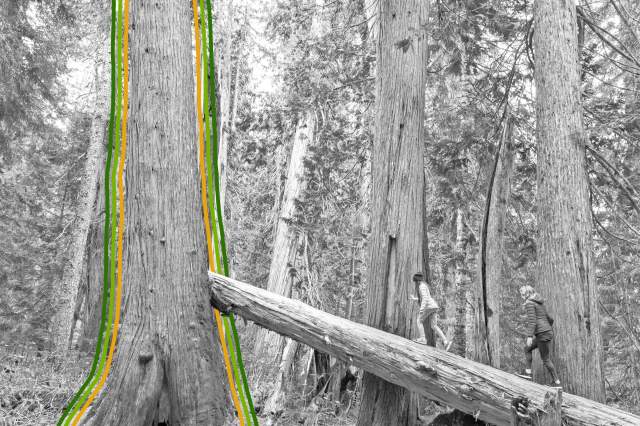
There Are 3.04 Trillion Trees on Earth
By most estimates, Earth is home to 3.04 trillion trees — that’s roughly 380 trees for every person on the planet. Among those trillions of trees are some 60,000 species spread across every country and continent except Antarctica (though even this frozen landscape was once home to temperate rainforests).
In fact, 3.04 trillion is so many trees that if it took you one second to count each tree on Earth, you’d be in for 95,000 years of number-crunching. But while 3.04 trillion is most definitely a mind-bogglingly large number, it’s nothing compared to the numbers on Earth before the end of the last ice age. Since the dawn of human civilization, the population of the world’s trees has declined by 46%.

Some Trees Can “Talk” With Each Other
While animals use different vocalizations to communicate, trees can also “talk” with each other, in an entirely different way. Underground, fungal threads called mycelia provide nutrients for trees, while trees provide much-needed sugars to the fungi. This symbiotic relationship is known as mycorrhiza, and because fungal mycelia are so plentiful in the forest floor, the trees are essentially “networked” together. Using this “wood-wide web,” trees can communicate when they’re stressed, deliver sugary sustenance to struggling trees, or warn about potential threats, such as insects or disease.

Some Living Tree Species Are Older Than Dinosaurs
Some of the trees shading you on a sunny day are the same kind that provided cool relief to the very first dinosaurs hundreds of millions of years ago. Take, for example, the ginkgo (Ginkgo biloba). This tree, with its eye-catching, fan-shaped leaves, is truly one of a kind and has no living relatives. In fact, it’s so old that the tree is often referred to as a “living fossil.” Scientists estimate that ginkgos first emerged on Earth some 270 million years ago, roughly 18 million years before the dawn of the Triassic, which saw the arrival of the very first dinosaurs.
The ginkgo actually faced extinction in our current epoch, before it was found in Japan in the late 17th century by German scientist Engelbert Kaempfer, who (re)introduced the plant to the Western world. Being both beautiful and disease-resistant, the ginkgo has become a popular tree in cities throughout the world. (At least the male trees have; female ginkgos produce particularly foul-smelling fruit.)
More Interesting Reads

More than 50% of Tree Species Are Endemic to Only One Country
The nearly 60,000 species of trees covering the globe vary greatly in their distribution. For example, the Ximenia americana (also known as the tallow wood) can be found in over 96 countries. But this small, shrubby tree is an exception to the general rule, as 58% of trees in the world are found in only one country. Overall, the nation with the highest number of tree species is Brazil, with an incredible 8,847 endemic tree species within its borders. Brazil is followed by Colombia (5,868 species) and Indonesia (5,716 species). When it comes to regions, the neotropics (Central and South America) have the highest diversity of trees, with around 24,000 species.

The Largest Plant Organism on Earth Is a Stand of Quaking Aspen in Utah
While coast redwoods (Sequoia sempervirens) are undisputedly the largest trees in the world, they aren’t the biggest tree organism overall — that accolade belongs to Pando, a stand of 47,000 quaking aspens (Populus tremuloides) south of Salt Lake City, Utah. Spread across 107 acres, Pando looks like a normal forest at first glance, but all the trees are genetically identical; aspens reproduce asexually, by sprouting from their root system. Because all the trees are clones of the original, which likely existed around 9,000 to 12,000 years ago, and they also share the same root system, Pando is considered one gigantic tree organism. Amazingly, Pando isn’t the largest organism in the world — a 2,200-acre fungal colony flourishes underground in eastern Oregon.

The World’s Oldest Forest Was Discovered in an Abandoned Quarry in New York
In 2019, scientists revealed an amazing discovery outside Cairo, New York, about two hours north of New York City. Locked away in 385 million-year-old rocks at an abandoned quarry were the woody roots of dozens of ancient trees of a genus called Archaeopteris. Although the site had been discovered a decade earlier, scientists didn’t quite know what they had until they analyzed the specimens, which revealed the oldest sample of ancient trees to date. The roots stretched around 18 feet from the base of the trunks and were both strong and intricate.
Archaeopteris is considered to be the first modern tree — it had flat, green leaves good for soaking up sunlight, sturdy trunks, and large, complicated root systems, just like the other trees we know and love today. It was common around rivers and coastal lowlands until it went extinct in the late Devonian Period, around 359 million years ago.

Palm Trees Are More Closely Related to Grass Than Trees
For years, there’s been a robust debate surrounding the question of the palm tree’s card-carrying tree membership. By some definitions, trees have a vascular cambium that produces wood, which palm trees do not. However, palm trees do provide shade, sequester carbon, and remove air pollution, just like other trees. The reality is that palm trees are a sort of in-between. These tropical staples have more in common with grasses and bamboos, as they’re in the same biological clade (known as “monocots”), so you could say they’re giant, woody grasses.
Tree or not, the 2,500 species of palms play a big role in fighting climate change, as they make up 60% of big stem “trees” (10 centimeters or bigger) in the Americas. Palms have also played a major role in human civilization, providing much-needed nutrients in the Middle East and North Africa, and have become symbols for some of humanity’s greatest cities — from ancient Rome to modern Los Angeles. They may not be trees, but humans clearly love them anyway.

Looking at Trees Reduces Stress
If you go on a walk through a forest, you’ll likely feel refreshed both mentally and physically. That’s because the human body has a unique, stress-reducing relationship with trees. According to researchers, even seeing a photo of a tree bolsters the parasympathetic portion of the central nervous system, which has an overall calming effect — though it doesn’t quite replicate the real thing. Spending time with our woody friends has been found to lower blood pressure, improve mood, strengthen the immune system, increase focus, and lower the stress-related hormone known as cortisol. Being overall tranquil locales, forests also contain higher levels of oxygen, which is a boon for our bodies, and chemicals known as phytoncides. Plants usually use these chemicals to combat pests, but they have the happy side effect of boosting cell activity in humans as well as contributing to many of the benefits already listed. So go out there and look at some trees — your health depends on it.











